Link building isn’t dead. But the old playbook is.
Google continues to value links as signals, but today’s wins come from PR-grade content that people want to cite.
In this guide, you’ll get a step-by-step system to build links with data-driven content and targeted pitching, plus templates, prompts, and real examples you can copy.
Use it to create content journalists will quote, improve your reply rates, and grow your visibility with links and brand mentions that deliver real value.
What Is Link Building?
Link building is the process of getting other websites to link back to your site to improve its authority and search engine rankings.
The most valuable backlinks come from trusted, relevant sources. They work like votes of confidence, helping search engines understand your site’s reputation while making it easier for people to find the resources you’ve created.
Why Links Still Matter
Google may be leaning less on backlinks than it used to, but they’re far from irrelevant.
In 2026, backlinks still help search engines and people alike figure out what content is worth paying attention to. Backlinks are:
- Still a ranking factor: Google still uses links to help it determine the quality of your site’s content
- A discovery path: Links help Google find new pages and understand how they fit into the web’s information graph
- An authority indicator: When links come from credible, relevant sites, they act as third-party endorsements of your expertise and can even boost your domain authority
- E-E-A-T-enhancers: High-quality links reinforce experience, expertise, authoritativeness, and trustworthiness (E-E-A-T) by showing that others in your field value your content
How to Get World-Class Links With Effective Link Building
Here’s how to run an active link building campaign that consistently earns high-quality links. Make sure to download our free tracking spreadsheet to monitor your efforts.
1. Create Linkable Content
Certain types of content work best for link building. We call this “linkable content” or link bait.
Here are a few types that work well:
Visual Assets
Visual assets — charts, diagrams, infographics — can earn links when people want to share a visual representation, not just a snippet of text. When someone embeds your graphic, they’ll often credit you with a link.
That’s why our Google CTR chart still drives backlinks years after we first published it.
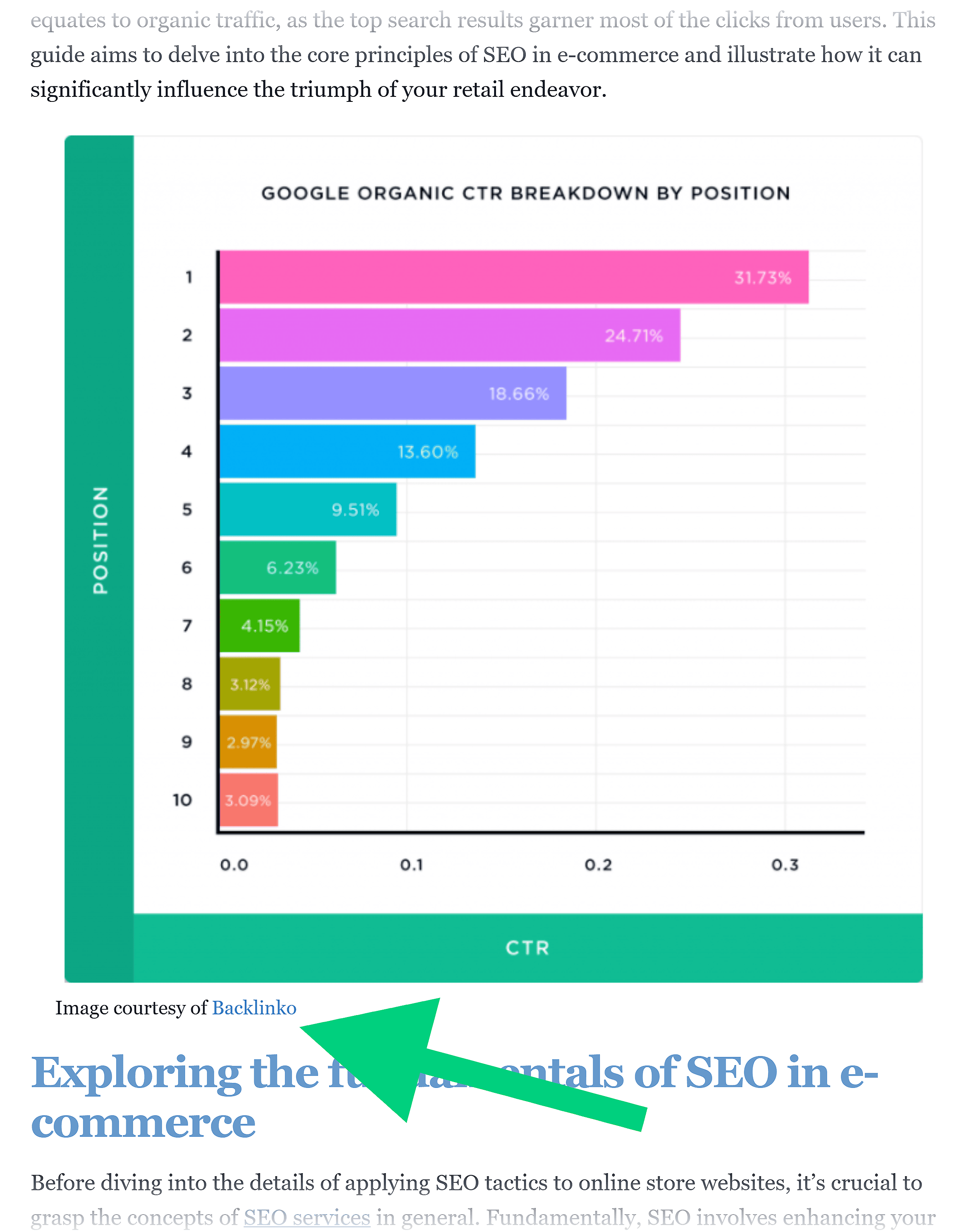
Original Research
Original research, like industry surveys, studies, or data analysis, is another great linkable format. We’ve taken advantage of this over the years with lots of studies…
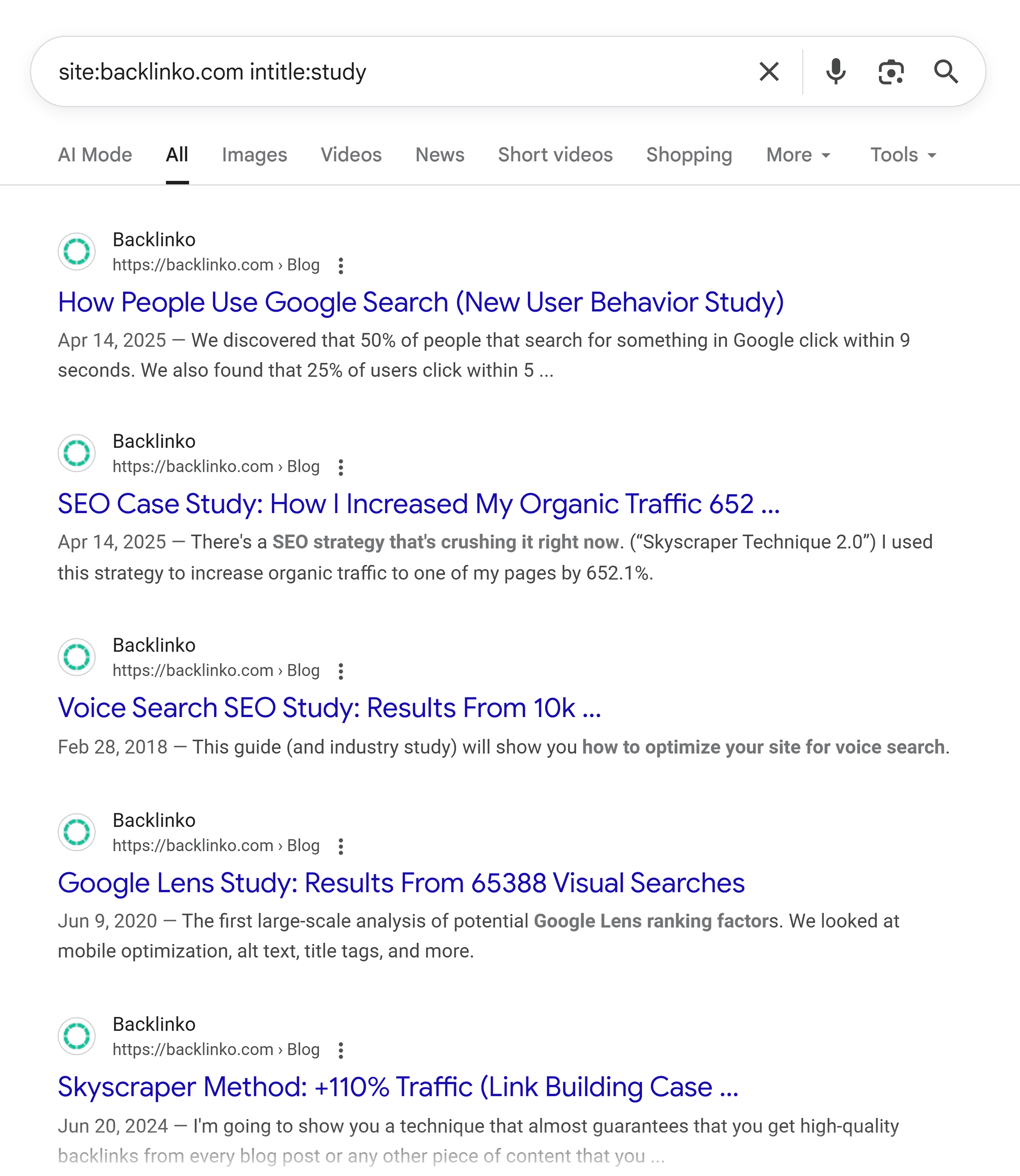
…that drive lots of links:
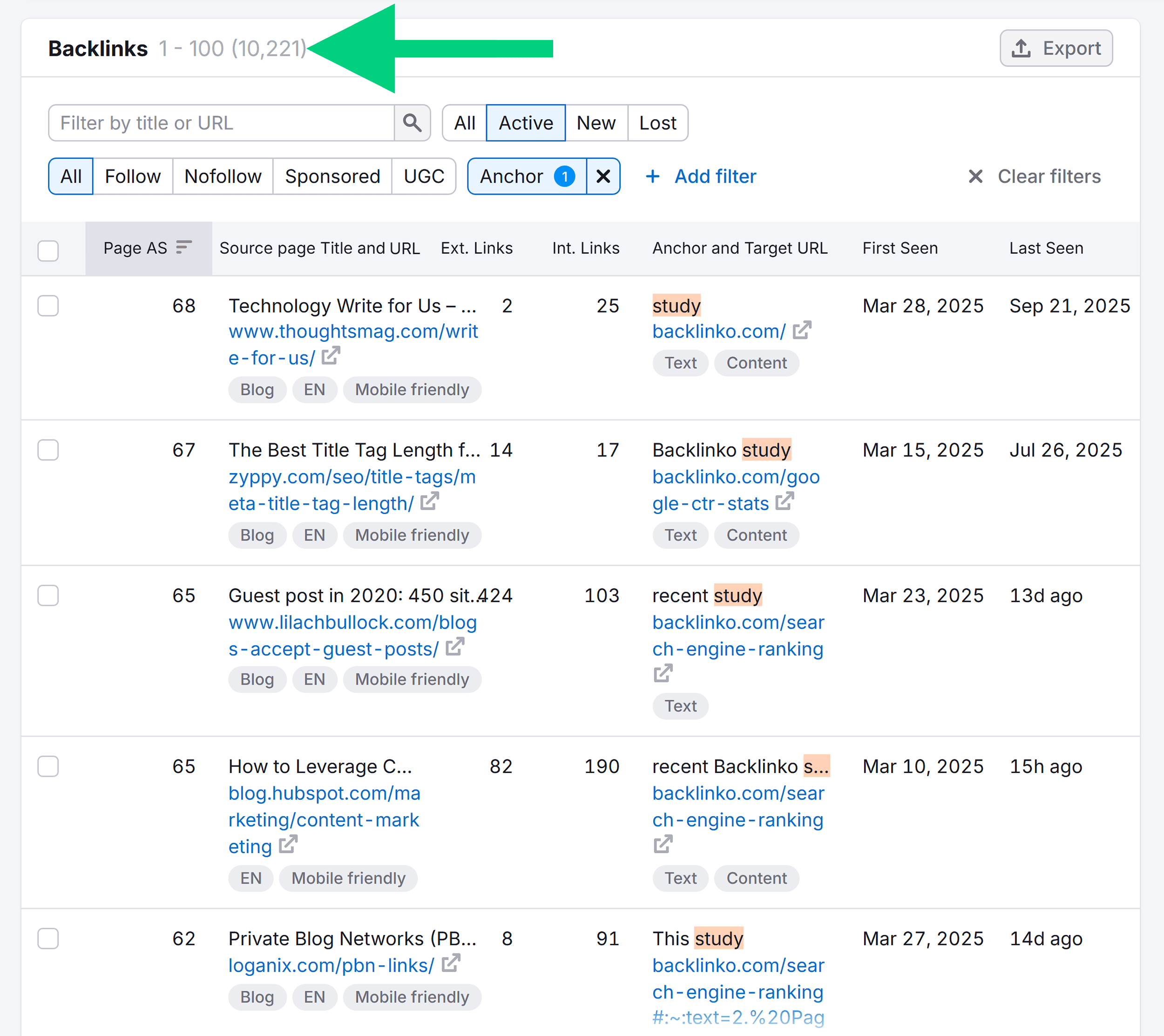
Here’s how you can use it:
- Pick a sharp question: Choose one timely, specific question your audience actually cares about. Then check interest in Google, Reddit, and recent news.
- Design a credible method: Spell out the basics in a “Methods” box — who you asked, how many, how you collected answers, when you ran it, and what key terms mean — plus any quality checks (e.g., removing bots/duplicates)
- Package for citation: Pull 8-12 standout stats with a source and year, add simple charts, downloadables, and plain-English captions so people can copy a line and credit you
- Lead with the angle: Write the headline and first sentence you want a reporter to use — and make sure your data clearly proves that story
- Publish and pitch on a hook: Time the release to a trend or calendar moment, and send it to writers who regularly cite data in your niche
Our own Google Ranking Factors study has picked up more than 75,000 backlinks, most of them from sites quoting original and reputable third-party stats from the report.

Free Tools
Another great way to build links while also providing a ton of value to your users is to create free tools.
These attract links because people naturally want to share great, free ways to do things.
We have a bunch of free tools here at Backlinko:
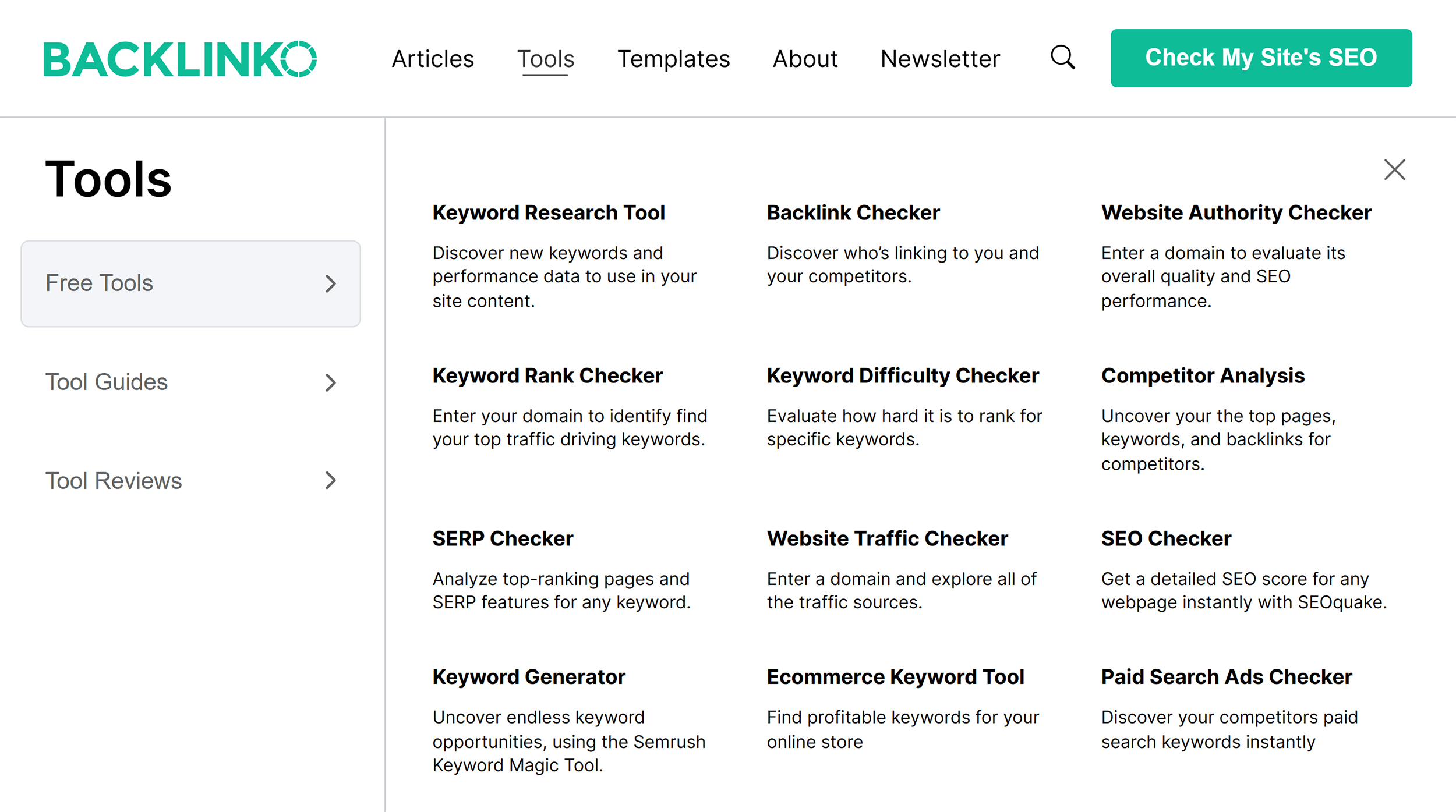
And they have attracted a TON of links:
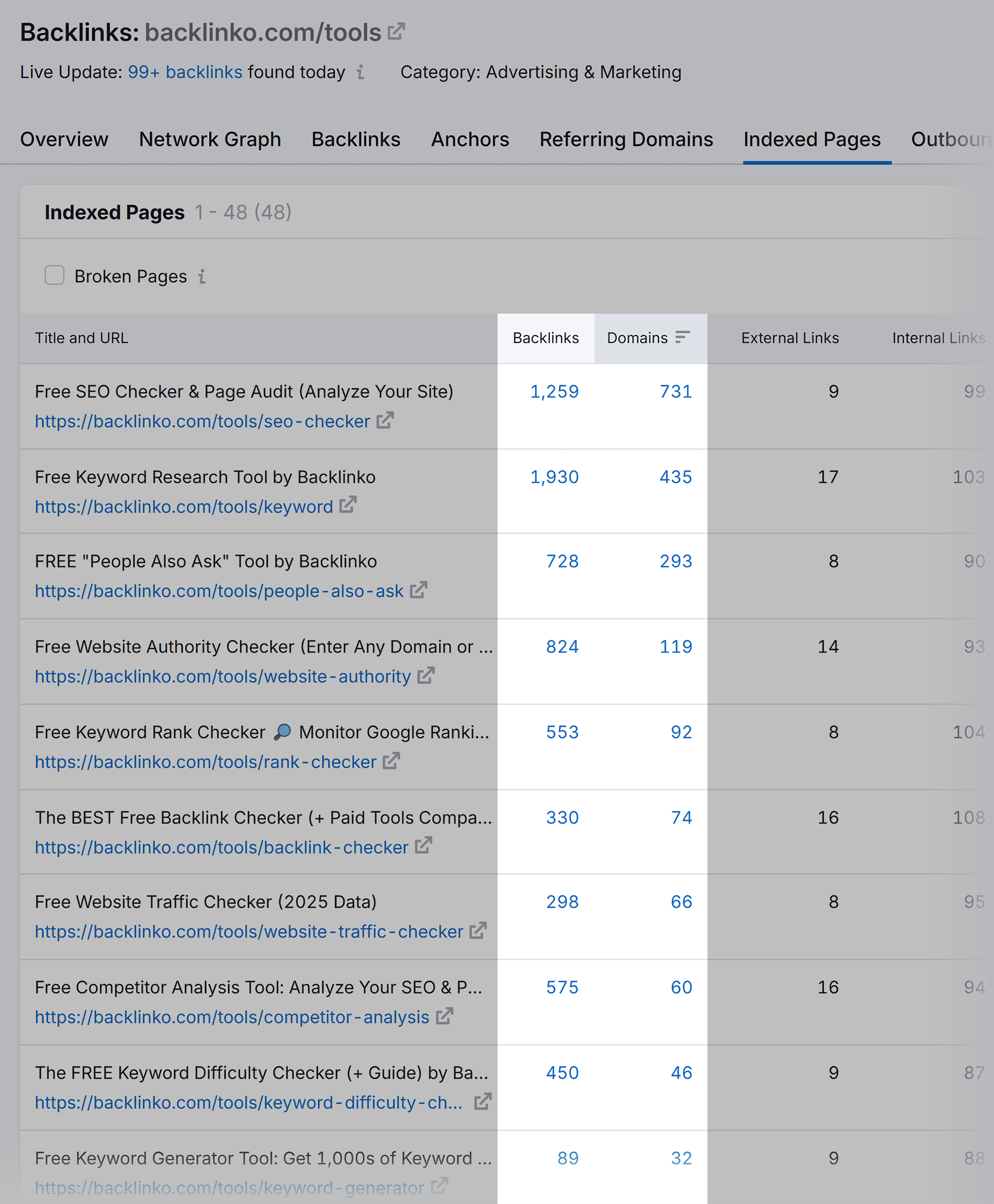
Free tools can take some time, effort, and expertise to create.
But if you can solve a user problem with a free tool, you can give your users what they want while also racking up backlinks in the process.
Ultimate Guides
Finally, ultimate guides can also work as great link bait. They’re comprehensive, multi-chapter resources that cover a topic from every angle.
Done well, they can become the go-to reference in a niche, earning links and citations over time. Backlinko’s Definitive Guide to Copywriting, for example, has attracted more than 1K backlinks from 300+ domains:
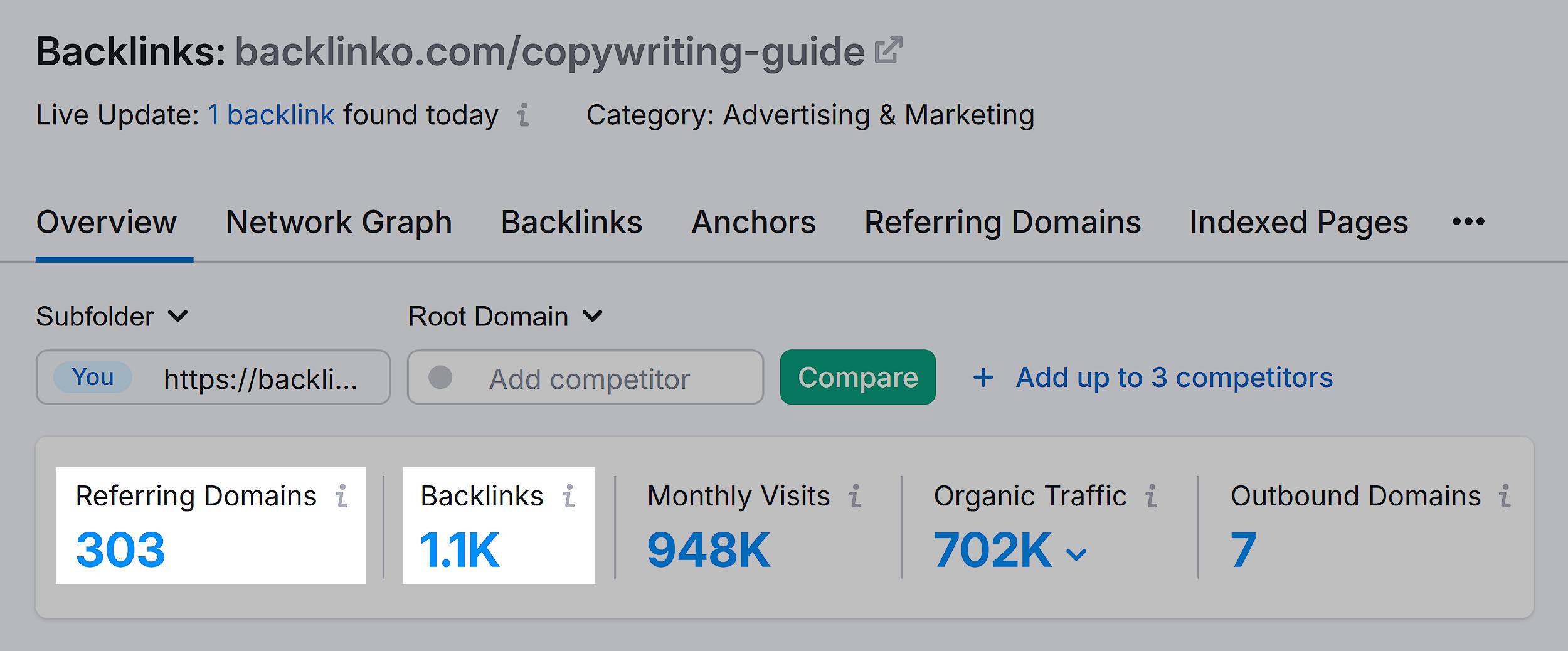
It works because it’s focused, structured, and complete. There are clear chapters, a sticky table of contents, updated examples, and answers to every common question on one page.

But:
More is not always better. In fact, it’s often not the way to go.
A massive guide that tries to satisfy every possible search intent can end up too broad to rank strongly or too overwhelming to be useful. Specificity often wins.
Guides that align tightly with a clear intent (like a beginner 101, a tactical playbook, or a deep technical walkthrough) tend to perform better in search and AI citations, since they map neatly to what users are actually asking.
2. Find High-Quality Websites to Pitch
Not every site is worth your time. To earn links that actually move the needle, you need to be picky about who you pitch.
Here’s how to separate high-value opportunities from dead ends:
Identify Authoritative, Topically Relevant Sites
Search your target topic and subtopics in Google and Google News. Note publishers that cover it regularly, and add industry associations, trade journals, and reputable blogs to a seed list.
Build on it by pulling competitor backlink reports using Semrush’s Backlink Analytics Tool. In particular, look at referring domains to their best-performing non-commercial content.
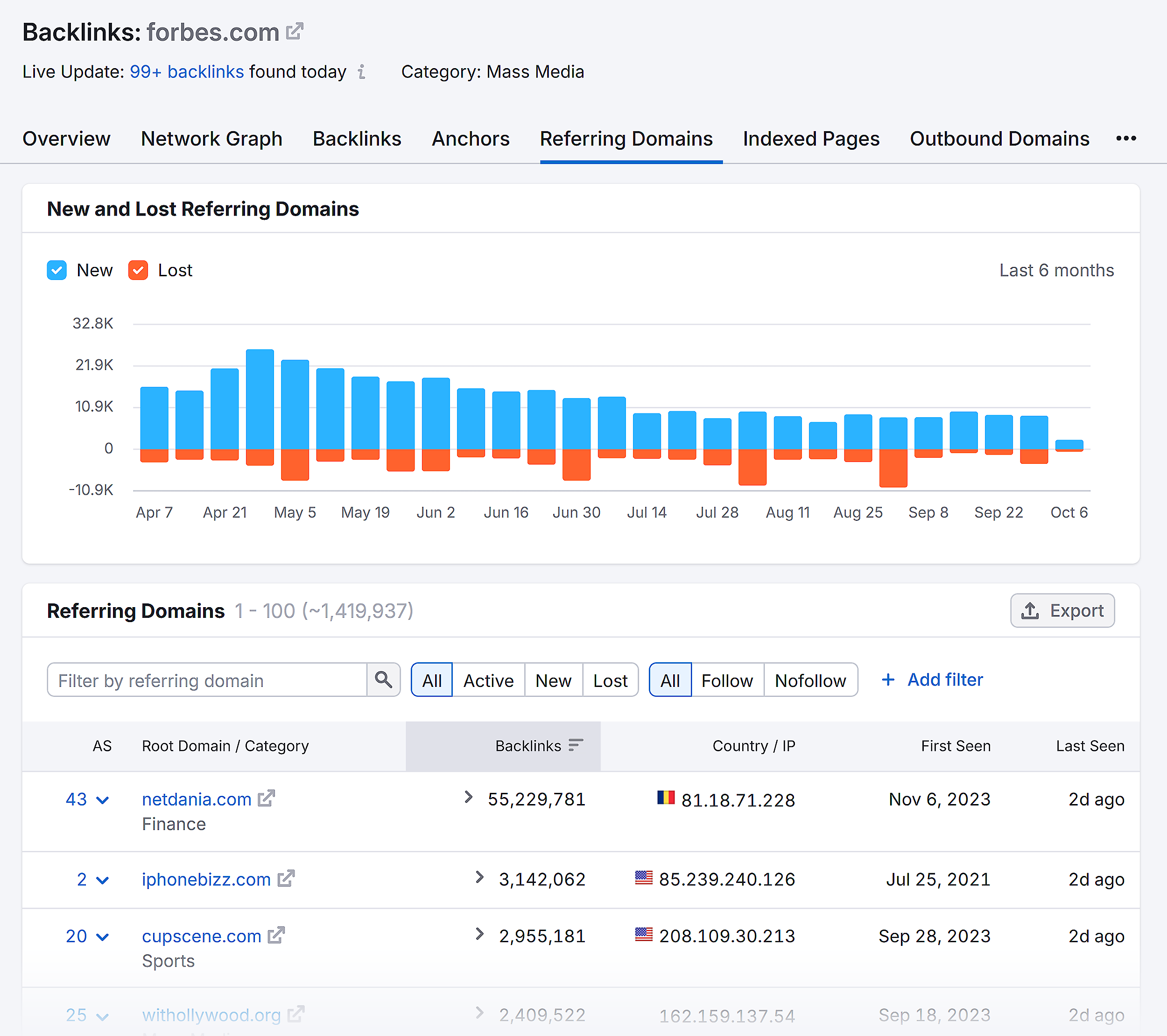
Then, use queries like this to surface curated resource hubs:
- “[topic]” inurl:links, site:.edu
- “[topic]” resources
- “[topic]” “helpful resources”
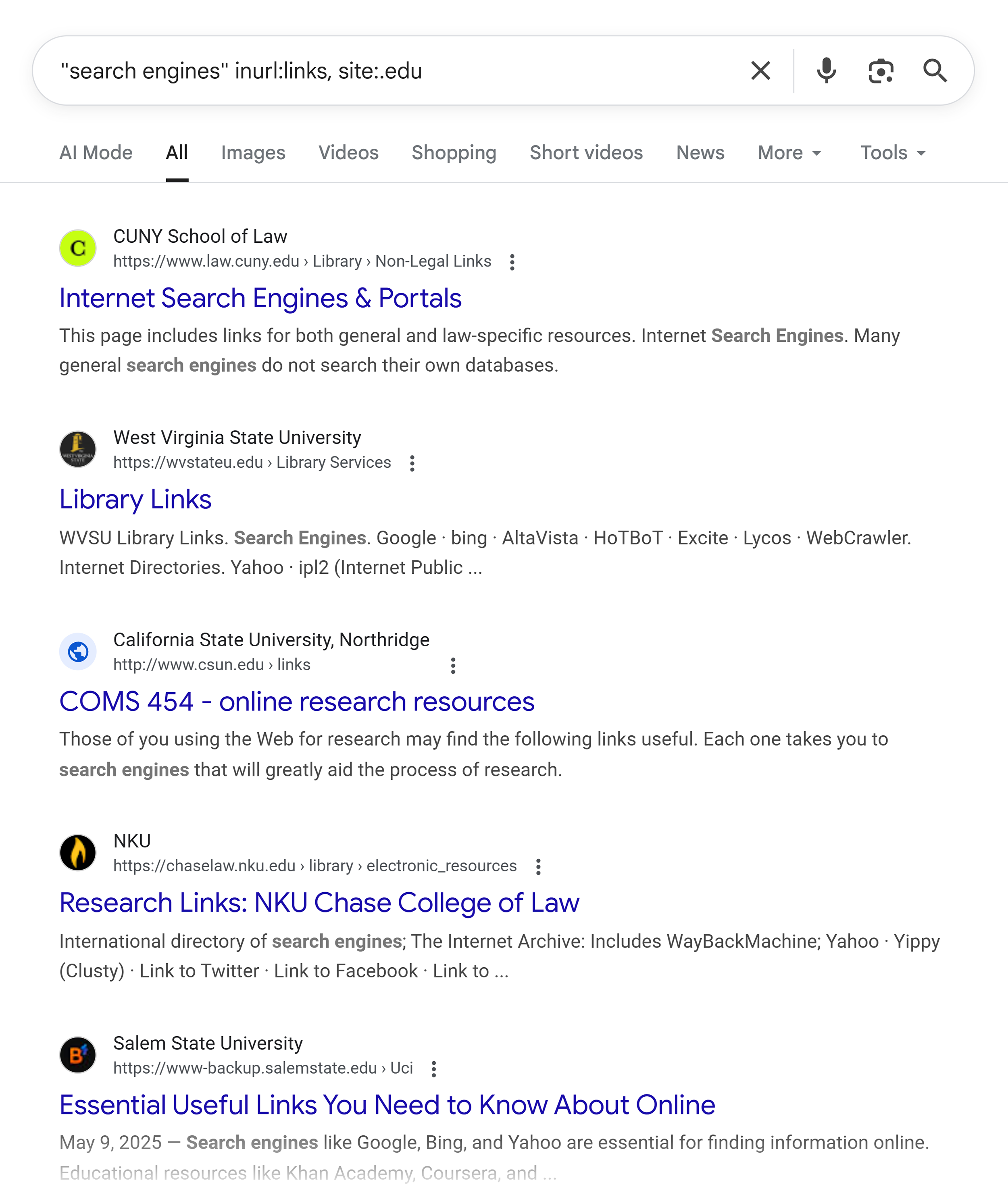
Check Authority and Traffic
Use tools like Semrush to get a quick read on link prospects’ Authority Scores (AS) and estimated organic traffic. The higher these numbers, the better. (Although sites with exceptionally high authority and traffic may be out of reach realistically.)
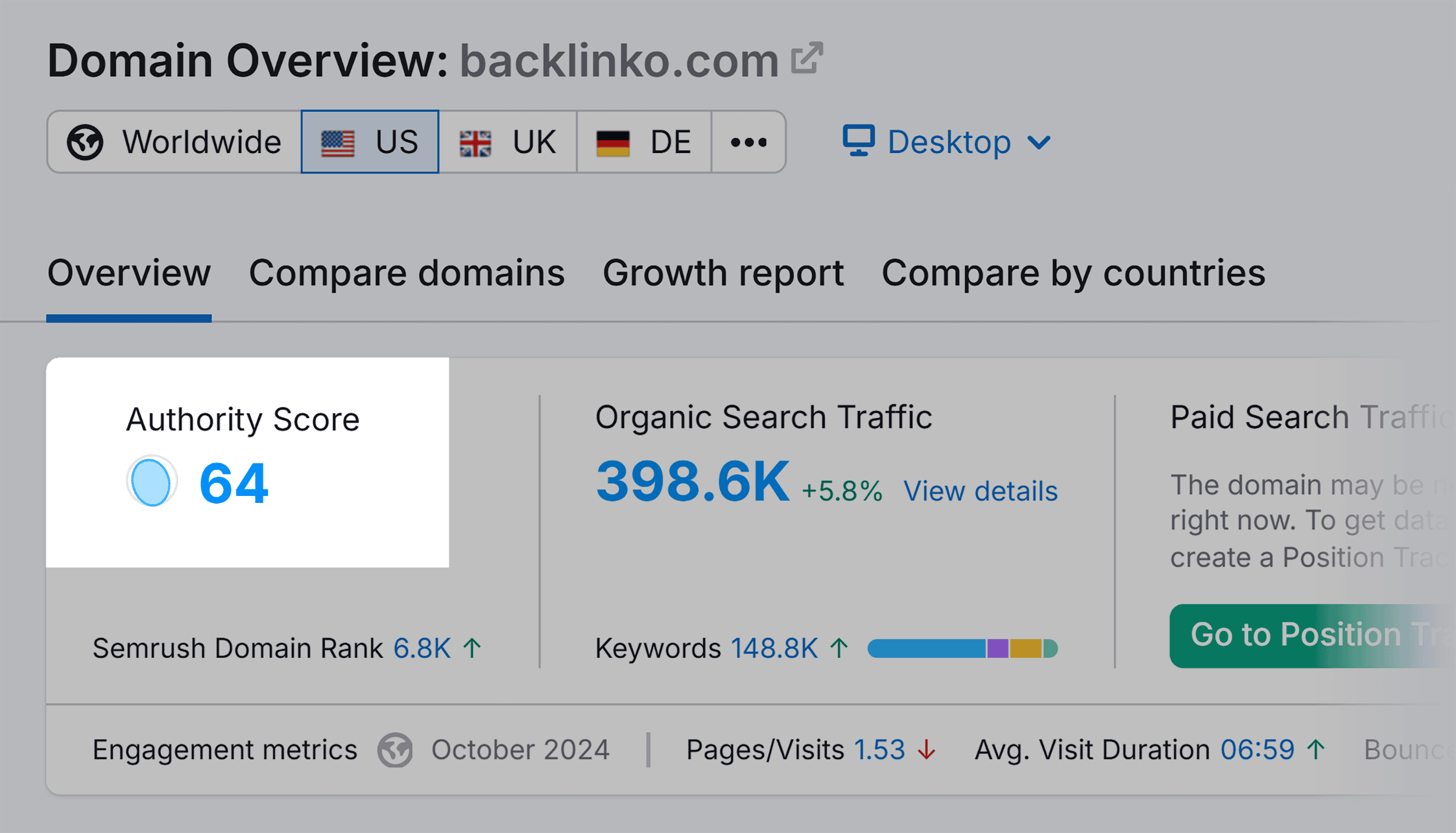
As a rule of thumb, target sites with real rankings and consistent traffic.
Also check the site’s outbound link quality.
Even high-authority sites can leak link equity if they regularly link to thin, off-topic, or spammy resources.
Scan a few recent posts. If you see casino/CBD/loan farms or obvious paid lists, skip it. The same goes for sites that appear to publish spun content. Quality sites and journalists worth getting links from usually have high editorial standards.
Find Journalists and Bloggers That Cite Data
Writers who frequently reference stats, research, or industry quotes are prime prospects
Use Google News, Twitter (X), or even LinkedIn search with queries like “site:linkedin.com + [your topic] + data” to find journalists who already care about your subject.
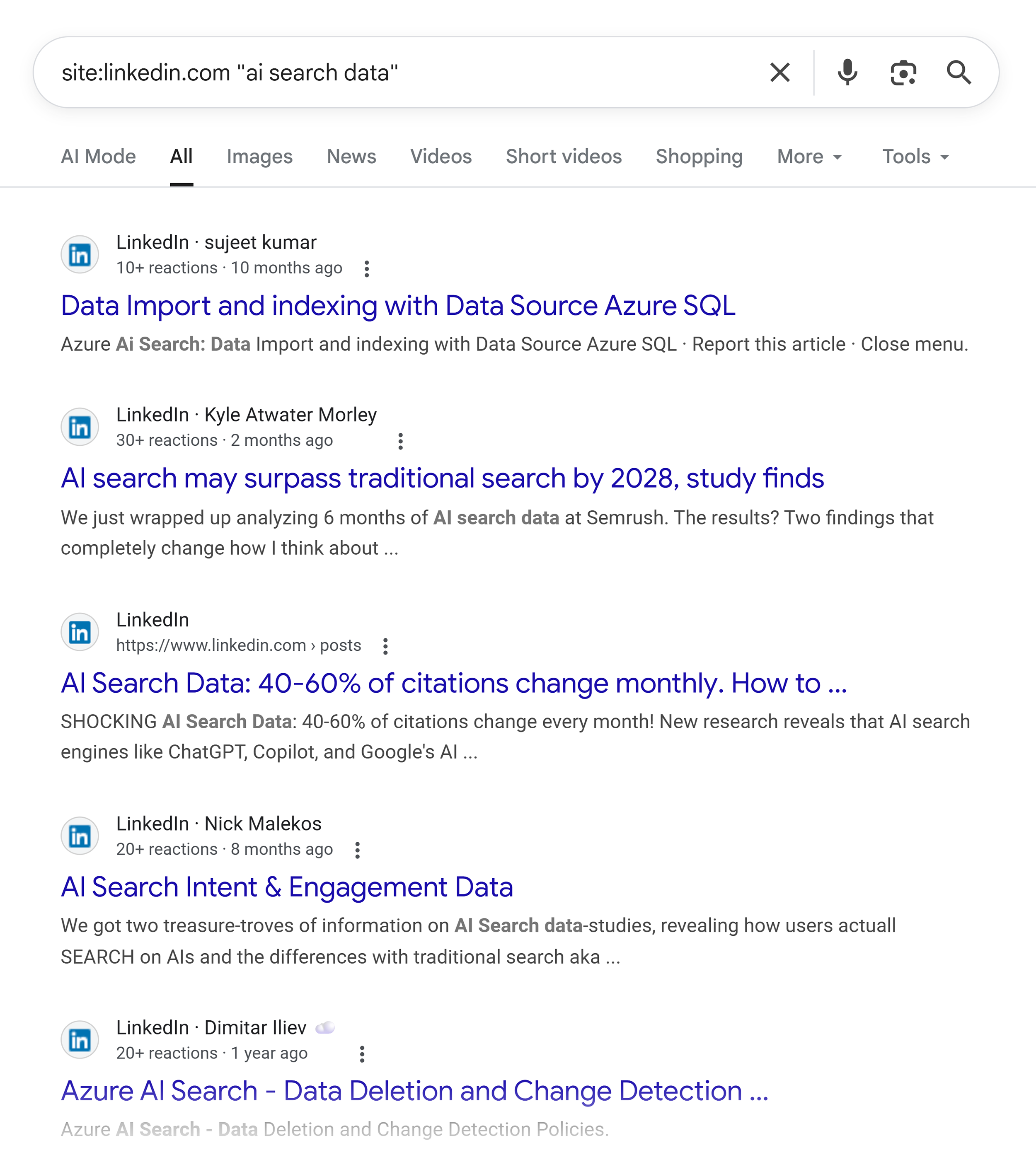
Check for Nofollow Links
When the rel=”nofollow” tag is added to a link, it tells search engines: “Don’t count this link as an endorsement.”
Obviously, when it comes to SEO, you want to get normal, “dofollow” links whenever possible. (Note that “dofollow” isn’t a tag or a real term, but we use it to denote links that don’t have a “nofollow” attribute.)
Here’s how to check:
Right-click on the page and select “View page source” to find the link in the HTML.

If you see a rel=”nofollow” attribute, it’s a nofollow link. If not, it’s dofollow.

Avoid Guest Posts
Steer clear of sites with mostly guest posts. This includes sponsored or paid posts. Many years ago, Google’s Matt Cutts came right out and said it:
“So stick a fork in it: guest blogging is done; it’s just gotten too spammy.”
– Matt Cutts, Former Head of Google’s Webspam Team
But what if you publish a mind-blowing guest post on an authoritative, relevant site? In our experience, that link CAN help you rank. Check out our full guest posting guide for more.
Build Segmented Outreach Links
Finally, organize your prospects into buckets like journalists, bloggers, industry sites, niche forums, and media outlets. This way, you can tailor your pitch.
For example, journalists need quick stats and quotes, bloggers might want a unique angle, and industry sites often look for data-driven resources.
You can use AI to find relevant prospects to pitch fast.
Here’s a prompt to get started:
You’re a link prospecting assistant. For the topic [your topic] in [your niche], find 30 relevant, high-authority prospects across:
- Journalists who recently covered it (with 2–3 article links)
- Resource pages
- Listicles that cite stats
- Sites that publish expert roundups with external links
Output a table with:
- Site
- Section
- Why they link
- Example URL
- Est. Authority Score
- Contact Path
Prioritize recency (<12 months) and topical relevance.
3. Gather Contact Information
Now that you’ve found a potential linker, it’s time to dig for their email address.
Here’s how:
Use Hunter.io.
Hunter.io is perfect for reaching out to small sites and one-person blogs.
Simply enter a site into the tool, and it’ll show you all the email addresses associated with that domain:

But what if you want to reach out to a massive site? Combing through this list is going to be a pain.
In those cases, we recommend VoilaNorbert.
Instead of popping in a URL, you enter a person’s name and the domain they work at.

That way, you’re reaching out to the person who can actually add your link to their page. (Okay, maybe you won’t reach Elon Musk, but you get the idea.)
You can also use paid tools like Muck Rack throughout the entire link building process. You can filter by sector, location, and even past articles they’ve written to find journalists who are
likely to want to link to you.
The best part? It’ll show you their contact information (where available), so you won’t have to dig for it.
Pro tip: Use a site’s contact form only as a last resort. It’s a black hole.
4. Send a Personalized Pitch
Nailing your outreach email is key if you want to build great links. A sloppy or generic pitch won’t just cost you a link — it’ll leave a negative impression of your brand.
Instead of blasting hundreds of spammy messages, focus on 100-150 highly targeted, personalized pitches per campaign.
One framework you can use is the classic AIDA copywriting model:
- Attention: Start with a personalized hook that shows you’ve done your homework. For example, you could reference a recent article, tweet, or podcast your prospect published.
- Interest: Share why your content is worth a look. What makes it unique? Is it new data, a fresh angle, or a more comprehensive resource than what’s out there? If you’re not excited about it, they won’t be either.
- Desire: Tie your content back to their audience. Point out a stat, graphic, or angle they could easily share to make their article stronger. Make it clear what’s in it for them, not just you.
- Action: End with one specific task. Instead of “share, link, or let me know,” focus on one action like “share with your readers” or “consider adding this resource to your piece.” It’s direct without being pushy.
When you’re pitching first-party data, cut the fluff and lead with your strongest stat in the first two lines.
Here’s an example prompt using the AIDA model:
Subject line: [NEW DATA] [Key surprising stat / trend]
Hi [First name],
[Intro of data point/key finding from your project that’s relevant to the prospect].
We surveyed [sample size and sample characteristics] to identify [purpose of survey].
Additional findings include:
[Additional data point]
[Additional data point]
[Additional data point]
You can view the full survey results here [link].
I thought this would make for an interesting story on [custom angle]. If you’re interested in covering it, I can send over additional data and/or embed codes to make sharing easier.
Thanks,
[Your email signature]
And here’s how it might look in action:
Subject Line: [NEW DATA] Gen Z’s top factor in choosing a bank isn’t rates — it’s digital experience
Hi Hannah,
A data review of Gen Z banking trends reveals that 80% of Gen Z trust their primary financial service provider to protect their personal data.
Since you recently covered how Gen Z approaches budgeting [1], I thought you might appreciate our new data on the key factors driving Gen Z’s banking decisions in the current (challenging) economic climate.
Statistics highlighted include [2]:
44% of Gen Z rely on platforms like TikTok and Instagram for financial advice
69% of Gen Z use their bank’s mobile app at least once a week
42% of Gen Z switched primary banking in the last year, often due to weak mobile experiences
73% of Gen Z say high-quality digital CX heavily influences provider choice
You can view the full data study here.
I thought this would make for an interesting story on how UX and trust — not rates — are reshaping Gen Z loyalty [3]. If you’re interested in covering it, I can send over additional data and/or embed codes to make sharing easier.
Thanks,
Leigh
Here’s why this works:
- Adds a tailored mention of the writer’s area of focus
- Builds interest with a brief summary of findings
- Suggests a possible story angle as inspiration
Keep your pitch under 200 words. The shorter and sharper it is, the more likely a busy editor or journalist is to read it all the way through.
5. Track and Monitor Responses
Once your personalized pitches are out, you need a way to track your progress.
We’ve built a free tracking spreadsheet that lets you do exactly that.
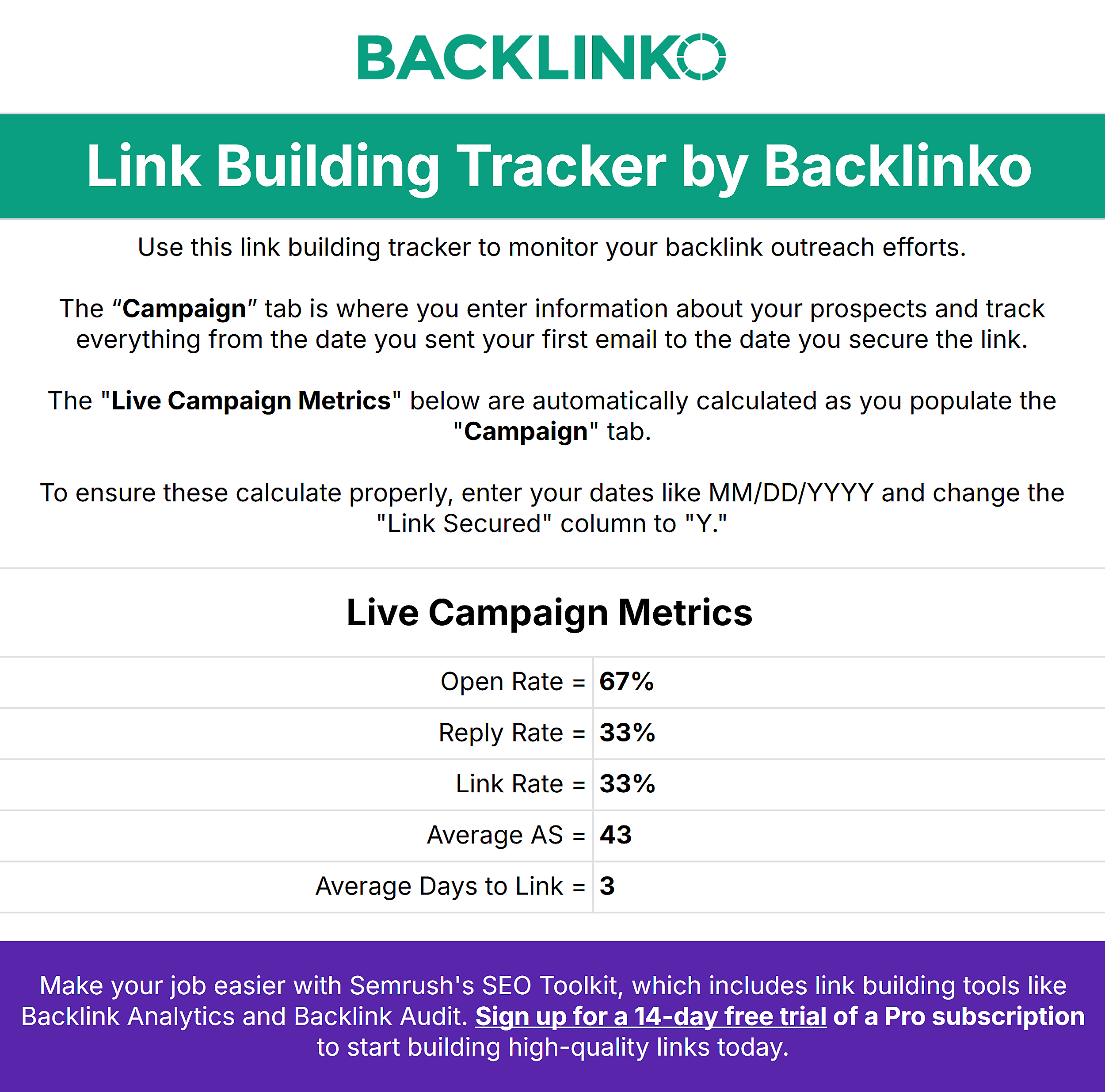
It helps you track your link prospects and whether you need to follow up with them.
If you don’t hear back, a short, respectful follow-up email is the norm. Five to seven days later often works best.
The sheet also automatically tracks and updates important campaign metrics like:
- Email open rate
- Reply rate
- Link rate
- Average Authority Score of the links you secure
- Average number of days it takes to secure a link
This will let you understand:
- Whether you need to improve your email subject lines to get more opens
- If your email copy may be holding you back from getting more replies
- How successful your link building efforts are over time
- The quality of the links you’re securing
Use this sheet throughout your link building campaign to help you continuously improve your content, emails, and overall outreach strategy.
Good Links vs. Bad Links
Google’s algorithms are designed to reward trustworthy, relevant sites and devalue less trustworthy ones.
If your backlink profile gets weighed down with spammy or manipulative links, it can drag down your authority and, in extreme cases, trigger a manual ranking penalty.
Even if that doesn’t happen, bad links send zero qualified traffic and waste your time.
The bigger risk is reputational. If a client, customer, or journalist sees your brand linked to a spammy directory, it reflects poorly on you.
Bottom line:
Good backlinks build authority and trust; bad backlinks chip away at both.
Knowing the difference between the two saves you time and headaches down the road.
Good Backlinks
Good backlinks come from:
- Relevant sites: Links from websites in your industry or niche that make contextual sense
- High-authority domains: Trusted sources with real traffic and editorial standards (think reputable blogs, media outlets, or resource hubs)
- Natural placements: Links that fit naturally into content, not shoehorned in
- Editorial control: Someone chose to include your content because it added value, not because you paid for placement
- Traffic potential: A link that doesn’t just boost SEO but also sends qualified visitors
Bad Backlinks
Bad backlinks often show up as:
- Link farms or private blog networks (PBNs): Networks designed only to sell links, with no real audience
- Irrelevant placements: Like a finance blog linking to your gardening site (with no context)
- Spammy directories: Listings with little editorial review and no actual value to users
- Over-optimized anchors: Keyword-stuffed text like “best cheap SEO service buy now”
- Low-quality content: Articles with thin or AI-spun copy that clearly exist only for link drops
Run a quick backlink audit every quarter to keep tabs on your link profile. Semrush’s Backlink Audit tool can quickly help you surface anything suspicious (foreign domains, irrelevant directories, exact-match spam anchors).
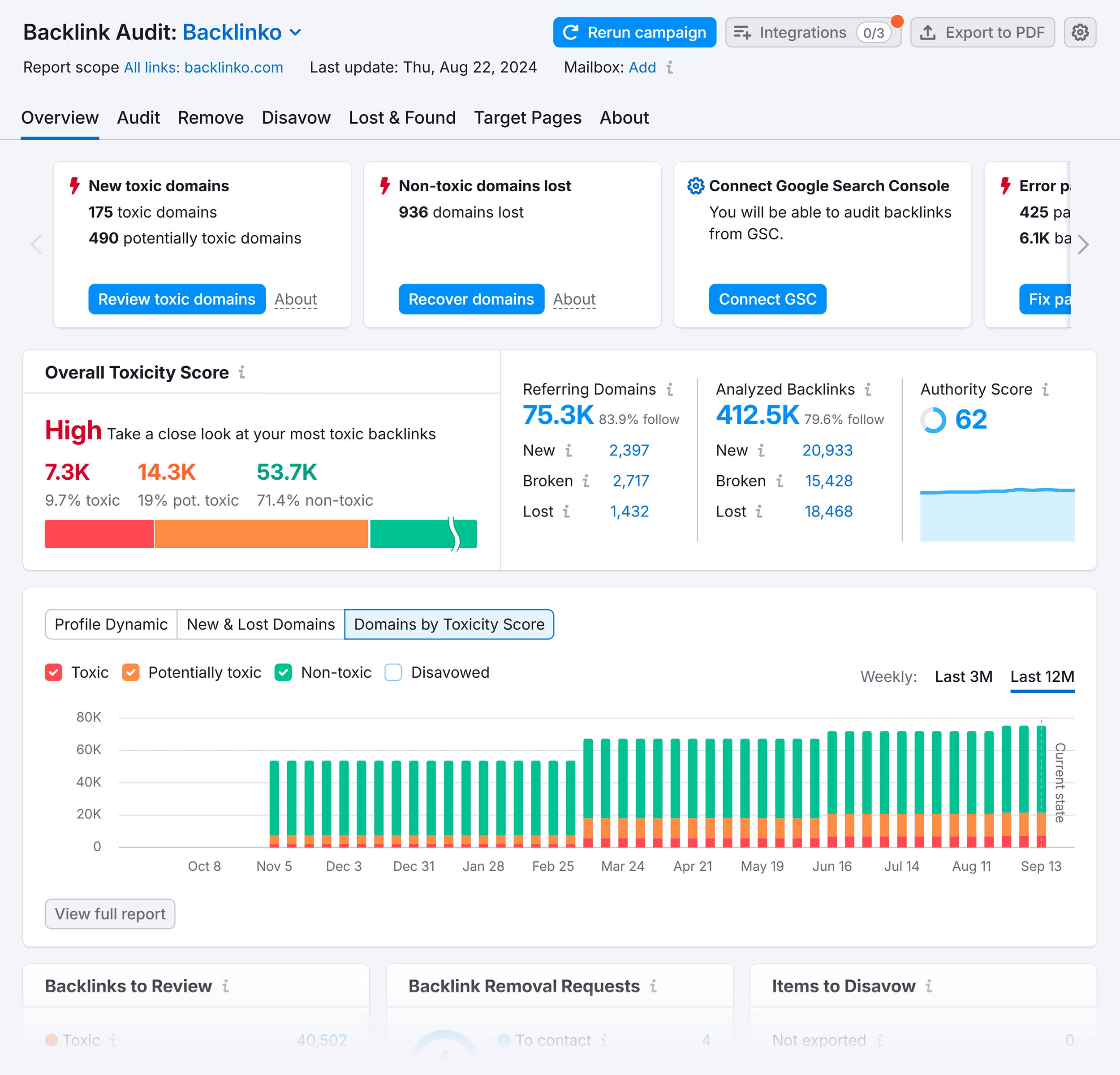
Don’t wait until your rankings dip to do this. Set a regular cadence so you can catch toxic patterns early and keep your link profile clean.
Even if you never build a single bad link yourself, you can still attract them naturally.
That doesn’t mean your rankings are doomed. But you should take steps to keep your backlink profile clean:
- Identify them early: Use tools like Google Search Console or Semrush to monitor your incoming links. Pay special attention to sudden spikes in links from unrelated or foreign domains.
- Don’t panic: A handful of spammy links usually won’t hurt you — Google’s algorithms are designed to ignore most of them. The real risk comes from large volumes of manipulative links.
- Try removal first: If you find a clear spammy directory or link farm, reach out to the webmaster and ask for the link to be taken down. (It doesn’t always work, but it’s a low-effort first step.)
- Use Google’s Disavow tool as a fallback: If you’ve identified a batch of toxic backlinks that could pose a risk and removal isn’t possible, you can upload a disavow file in Google Search Console. This tells Google to ignore those links when evaluating your site.

But use the disavow tool with caution. Most site owners won’t ever need to touch it.
Further reading: Toxic Backlinks: How to Spot and Avoid Them
Build Links That Build Authority
Whether you’re chasing high-authority backlinks or refreshing old assets to make them more link-worthy, the fundamentals of good link building don’t change.
The tactics evolve, and the platforms shift. But the core principle stays the same. You need to earn links by creating content that’s genuinely worth citing.
When you focus on relevance, authority, and usability, the rankings — and brand trust — follow.
Check out these resources for next steps to build links that grow your site’s authority:
Backlinko is owned by Semrush. We’re still obsessed with bringing you world-class SEO insights, backed by hands-on experience. Unless otherwise noted, this content was written by either an employee or paid contractor of Semrush Inc.




